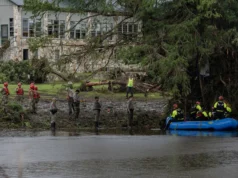 Residents are beginning to return to assess the damage and start the long, slow road to recovery as Hurricane Michael left its indelible marks after it ploughed into coastal areas of Florida.
Residents are beginning to return to assess the damage and start the long, slow road to recovery as Hurricane Michael left its indelible marks after it ploughed into coastal areas of Florida.
“So many lives have been changed forever, so many families have lost everything,” The state’s governor, Rick Scott said.
The worst hit areas of Florida’s northwest coast saw houses ripped from their foundations, trees felled, and power lines strewn across streets.
Hurricane Michael struck on Wednesday with winds of 155mph (250km/h).
It weakened to a storm as it moved inland towards the north-east, but at least eleven people have died, most of them in Florida.

More than 370,000 people in Florida were ordered to evacuate but officials believe many ignored the warning.
Governor Scott said the US Coast Guard carried out 10 missions overnight, saving at least 27 people.
FEMA Administrator Brock Long said he expects that the number of casualties will continue to rise. As of Friday morning, more than 1.4 million utility customers from Florida to Virginia were without power.

Mexico Beach, Florida, was one of the hardest-hit areas. Entire blocks of homes were obliterated in the small Panhandle community.
Thousands of National Guard troops and emergency workers are helping the survivors. On Friday morning, Michael’s remnants were over the Atlantic Ocean, lashing the New England coast with strong winds and heavy rain.






